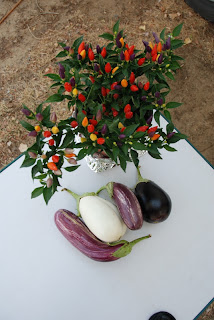It appears that,
although the local mosquitoes are voracious, their bites are not as
potent as many. We still have lots of visible wounds but they are not
itching as they do normally.
After a quick walk to
the supermarket to collect fresh bread and other supplies, we had
breakfast outside without any hindrance from mosquitoes. Then it was
on the road again heading east.
We again took the old
national road 2 and this turned out to be a particularly good choice
as we passed lots of archaeological sites. We didn't have time to
stop at most of them but have noted that we need to investigate them
at a future date. We stopped at two Macedonian tombs cut into hills
on the coastal stretch of the 2 just north of Asprovalta. The second
was especially impressive, complete and the gates were open to allow
public access.
There seems to have
been an interim national road 2 between the original one that ran
along the coast and the new motorway. This road runs inland from Nea
Kerdillia to Kavala and as we drove away from the coast to find it we
came across the the Lion of Amphipolis. We have seen this before (and
the impressive, nearby site of Amphipolis) but I had to stop to have
another look. As you will see from the photograph, the beautifully
sculptured lion is massive and it was a huge task to put together the
animal from the the thousands of pieces found over years of
excavation. It was created in the 4th century BC as a
funeral monument to Admiral Leomedon who was a devoted companion of
Alexander the Great.
Just before Kavala we
came to the town of Eleftheroupoli and it was very busy. I guessed
correctly that it was market day and we were soon in the centre that
was bustling with people. It was here that we had a very near miss. I
was driving slowly, fortunately, as a man walk straight out into the
road without looking right in front of the van. I stood on the breaks
and with an awful screech came to a halt about six inches from him.
He realised too late that I was there and he stood in a state of
shock as I stopped. A lucky escape for both of us!
We stopped on the
outskirts of the town and walked back in again to spend some time in
the market. It was a very good one with plants, fruit &
vegetables, other food stalls and a huge number of clothes stalls. We
bought forest honey, pasta, aubergines, beans and a lovely coloured
pepper plant. That was followed by pitta souvlaki in a small café.
We felt really Greek!
Passing through Kavala
we actually drove under the Roman Aquaduct that used to supply the
city with water. We thought on stopping in Xanthi but decided that,
as we had no idea where to park or where the old town was, it was
going to take too long.
We had found Mandra
Beach campsite on the excellent ACSI site (www.eurocampings.co.uk)
and decided to try to find it. We made it in the end but there was a
fair amount of guesswork involved as there were no signs to it. This
was the first Greek campsite that we have been to where 99% of the
campers were Bulgarian (we were the 1%). For a brief period before
WWI, this area of coast was Bulgarian and it is very accessible from
southern Bulgaria. The campsite is next to the beach and the water is
very shallow for a long way out so it is very safe for children. I
suspect that this and other campsites along the coast were on the
point of failing before the Bulgarians joined the EU. Now it is
really thriving.
Photos: Close-up of the Lion
of Amphipolis; Gourds in the Eleftheroupoli market; Our purchases –
a pepper plant and three different types of aubergines.



No comments:
Post a Comment